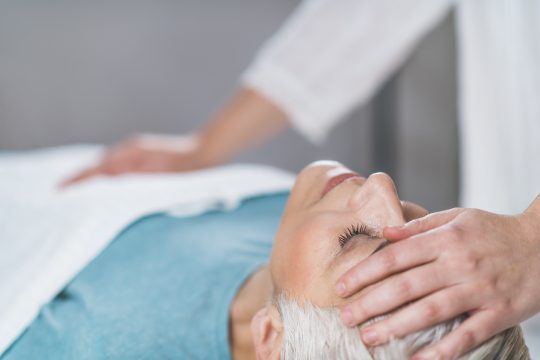Bodywork
CranioSacral Therapy
Energetic Trauma Release
Polarity Balancing
Integrated Energy Therapy
-Service Rates-
Sessions for all modalities* of Massage, Energywork, and Bodywork are:
- $85/hour
- $105/hour and 15mins
- $120/hour and a half
- $150/2 hours
*Children’s and infants’ sessions are $65/hour.

CranioSacral Therapy:
TLDR:
- Very gentle
- Fully clothed
- Connective Tissue/Fascia Modality
- Useful to treat a wide variety of complaints
- Clinically researched
- Developed by an Osteopathic Physician
- Often useful to treat migraines and chronic pain
- Can be safely performed with infants, toddlers, children, and adults of all ages/stages of life
“CranioSacral Therapy (CST) is a gentle, hands-on approach that releases tensions deep in the body to relieve pain and dysfunction and improve whole-body health and performance.” It was pioneered and developed by Osteopathic Physician John E. Upledger after years of clinical testing and research at Michigan State University where he served as professor of biomechanics.
In a CST session, practitioners gently [palpate (feel for) and] release restrictions in the soft tissues that surround the central nervous system. CST is increasingly used as a preventive health measure for its ability to bolster resistance to disease, and it’s effective for a wide range of medical problems associated with pain and dysfunction.”
How does it work?
Just as your muscles can develop tension and pain due to stress and strain, so too can the connective tissues of your body. The restrictions and adhesions in the tissues create a sort of tug-of-war within and among the tissues of the body resulting in discomfort, pain, misalignment, and even disease. CranioSacral Therapists are trained to find these restrictions and gently facilitate the body in releasing them. All systems of our body function better when properly unrestricted, when there is space for movement. When we decompress our joints via massage, our range of motion improves. When we remove plaque from our arteries, our blood flows better. Without excess mucus in our lungs, we breathe deeper and easier. When our muscles release a habitual hold that was constricting our lymphatic system, our body is then better able to remove waste. CST is another means of creating space in the body, most specifically in the connective tissue of the fascia and in the outermost membrane that protects the brain and spinal cord (the dura mater membrane). This release of tension along with stimulation of the parasympathetic nervous system (the ‘rest and digest’ state our body uses to heal and regenerate) allows your body to function better and to continue to heal itself. (For a more in-depth and empowering look at this concept and how it relates to disease, please consider reading Dr. Upledger’s book, Your Inner Physician and You.)
“By normalizing the environment around the brain and spinal cord and enhancing the body’s ability to self-correct, CranioSacral Therapy is able to alleviate a wide variety of dysfunctions, from chronic pain and sports injuries to stroke and neurological impairment.”
While it can indeed facilitate healing in a number of conditions, CranioSacral Therapy does not profess itself to be a panacea. If the cause of your ailment lies within an imbalance in the CranioSacral system, then it is most likely that CranioSacral Therapy will help you. If the cause is due to another type of imbalance, then another modality might offer you more relief.
What conditions can CranioSacral Therapy address?
- Migraines and Headaches
- Chronic Fatigue
- Concussion and Traumatic Brain Injury
- Fibromyalgia
- Chronic Neck and Back Pain
- TMJ Syndrome
- Autism (*please note: this is not an attempt to claim a cure for Autism or ASD. As someone who identifies as having Asperger’s, I do not believe ASD needs a cure. There are some complications and difficulties associated with being on the autism spectrum, however, and CST may help to alleviate some of those difficulties. This is a much more involved conversation than this note can address. Please feel free to contact me with questions or comments.)
- Scoliosis
- Stress & Tension-Related Disorders
- Central Nervous System Disorders
- Motor-Coordination Impairments
- Learning Disabilities
- ADD/ADHD (*please note: again, this is not an attempt to claim a cure. ADD/ADHD is a form of Neurodiversity. It comes with myriad gifts in addition to its challenges. CST might help to mitigate some of those challenges by calming and balancing the nervous system.)
- Brain and Spinal Cord Injuries
- Post-Traumatic Stress Disorder
- Orthopedic Problems
- And many other conditions.
- It has also more recently been used specifically as part of a pre- and post-op protocol as a complementary therapy for ankyloglossia/‘tongue-tie’ surgeries.

Energetic Trauma Release:
TLDR:
- Light-touch
- Fully clothed
- Nonverbal
- 1-3 sessions recommended
- Great for Anxiety, Depression, PTSD, and CPTSD
This light-touch energy modality is used to aid the body in letting go of the trauma response. It was adapted from a technique used to help war veterans return to civilian life. ETR is taught to be a “healing sequence for releasing stuck fear patterns and calming the runaway heart.” This technique is done by working with the body’s limbic system (the emotional brain), specifically the amygdala, hippocampus, prefrontal cortex, brainstem, and adrenals, as well as the heart, solar plexus, and root chakras. While our goal is not to erase memories (after all, memory is part of learning), it is beneficial to neutralize an unhealthy or unhelpful strong charge associated with a traumatic event. The analogy I like to use often is one that many of us can relate to: an auto accident. While it is helpful to be a more vigilant driver after having been in a collision, it is not helpful to have so much fear or anxiety that you have a panic attack every time you drive or every time you approach the familiar intersection. We learn, grow, and heal when our parasympathetic nervous system is engaged, not when we’re in fight or flight (or freeze/fawn–another type of trauma response). Something that can be very appealing about ETR is that it is also nonverbal. The narrative is not important for releasing the energy from the body.
*That being said, often it can be quite beneficial to pair this work with professional counseling or psychotherapy (and I highly recommend this for anyone dealing with significant trauma, early childhood trauma, or deep emotional trauma/abuse, and I’m happy to offer recommendations for Licensed Professional Counselors in the area).
While one session of ETR usually offers significant relief, it is recommended to consider committing to 3 sessions (usually spaced apart by as little as one week and as much as one month between sessions) so that the body can build from the benefit cumulatively.

Polarity Balancing:
TLDR:
- Light-touch
- Clothed
- Based in Ayurveda
- Gentle
- Works on 4 levels of the body (physical, mental, emotional, spiritual)
- Great for those new to energy work
Polarity Balancing is a light-touch form of energy work based in Ayurveda (an ancient Indian science known as the sister science of yoga). The basic premise of Polarity work is that each person’s body is mapped with positive and negative poles, similar to a battery. When we, as facilitators, connect those poles with our hands or fingertips, it creates a current of electromagnetic energy in a client’s body. This current is a subtle vibration. Through this subtle vibration via various protocolled patterns, the client’s body shifts toward homeostasis (balance). Maruti Seidman developed an entire book of protocols to address a wide variety of complaints (such as but not limited to: arthritis, anxiety, digestion, chakra balancing, emotional balance, mental clarity, skeletal structure balance, etc) as well as sessions to enhance an already healthy body/mind (such as: the Oneness Session, spiritual balance, inner peace session, compassion session, core alignment, five element balance, and the intuitive session).
A Polarity session is approximately one hour long and is done with the client remaining fully clothed. It makes a great introduction to bodywork for anyone new to therapeutic touch.

Integrated Energy Therapy:
TLDR:
- Gentle touch
- Fully clothed
- Seeks to remove energy blockages in the life-force energy pathways
- Facilitates the body’s movement toward homeostasis/balance/well-being
Integrated Energy Therapy (IET) was developed in 1987 by Stevan J. Thayer (inspired by his guide, Angel Ariel). IET seeks to remove energy blockages in the electromagnetic energy field of the body. This field of energy has many names depending on the tradition speaking about it, eg “Ki (Japan), Chi (China), Prana (India), Argon, Innate Intelligence, Love, Qi, the Force, and Tao.” “Some of the causes of energy blockages are: physical trauma, surgery, disease, exhaustion, starvation, emotional crisis, suppressed feelings, stress, fear, self-limiting thoughts, and karma. Energy blockages limit our experience of life and can result in lack of spontaneity, energy depletion, and even disease.”
IET works with a specific energy pathway known as the Integration Channel. It rebalances the energy of the body’s cellular memory. An IET practitioner works as a facilitator or assistant to the body’s natural and innate intelligence to move toward homeostasis/balance/health/well-being. IET is not intended to diagnose, treat, or heal disease. It is a complementary tool to create an environment within the body that is supportive of healing. IET practitioners work with a client’s body by “integrating” and “energizing” different points of the energy-body using a light-touch treatment protocol developed by Stevan J. Thayer. As the client is supported in clearing an energy blockage, the previously suppressed charge of energy dissipates and rebalances within the body’s energy field. “As this happens, the client may have many reactions, eg feeling nothing (healing without feeling), feeling sensations (vibration, tingling, pressure, temperature change, etc), or feeling emotions (anger, sadness, etc).”
